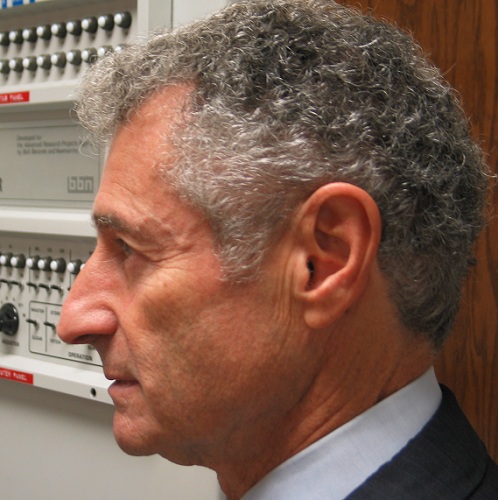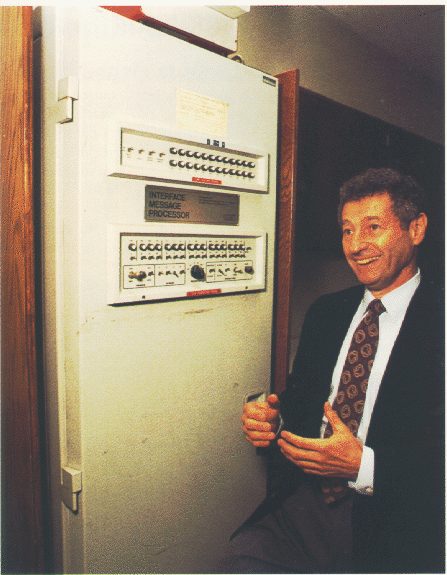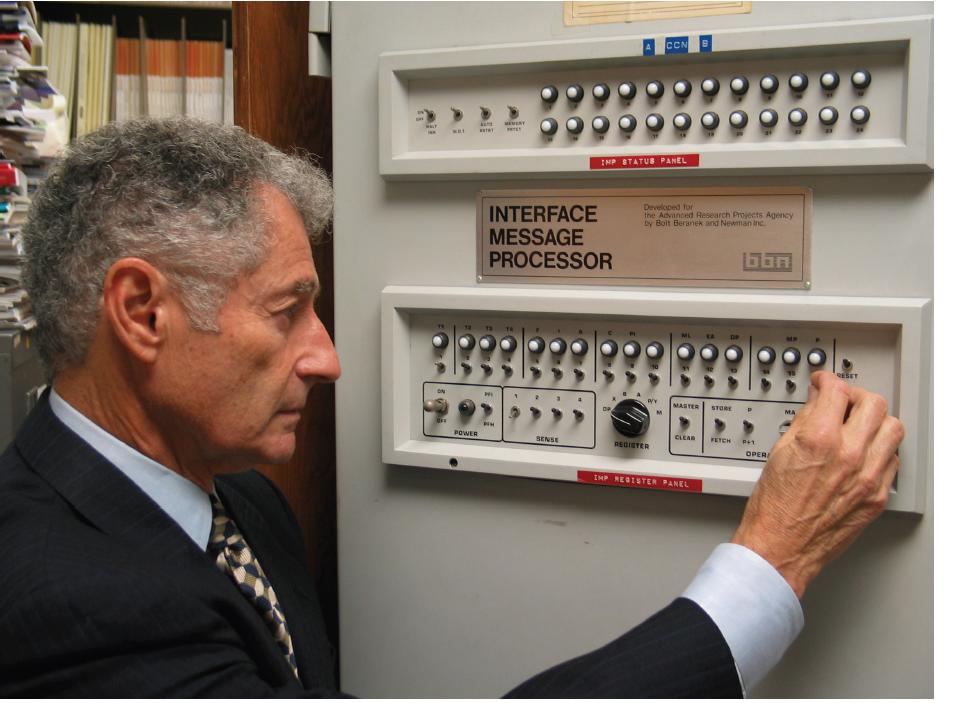| |
 |
This interview |
| |
| "We watched anxiously as we turned on the connection over a 15 foot cable between the two machines and waited for the bits to flow. Happily, the bits began to flow flawlessly. It was marvelous. At that moment, the infant Internet took its first breath of life!" - Leonard Kleinrock |
| |
Other Interviews |
| |
| "Stanford's distinguishing characteristic is its pioneering spirit and focus on research that contributes to the public good." |
| - Dr. John Hennessy, President of Stanford University |
|
|
Interview with Professor Kleinrock, on the occassion of 40th birthday of the Internet
|
|
September 2009
|
|
The Internet turned 40 on September 2nd, 2009. We are celebrating the occassion by talking to Professor Leonard Kleinrock, considered a father of the Internet. Dr. Kleinrock is a Distinguished Professor of Computer Science at Dept. of Computer Science, UCLA. He developed the mathematical theory of packet networks, the technology underpinning the Internet, while a graduate student at MIT. This was in the period 1960-1962, nearly a decade before the birth of the Internet which occurred in his laboratory when his Host computer at UCLA became the first node of the Internet in September 1969. He wrote the first paper and published the first book on the subject; he also directed the transmission of the first message ever to pass over the Internet.
|

|
|
He was listed by the Los Angeles Times in 1999 as among the "50 People Who Most Influenced Business This Century". He was also listed as among the 33 most influential living Americans in the December 2006 Atlantic Monthly. Kleinrock's work was further recognized when he received the 2007 National Medal of Science, the highest honor for achievement in science bestowed by the President of the United States. This Medal was awarded "for fundamental contributions to the mathematical theory of modern data networks, for the functional specification of packet switching which is the foundation of the Internet Technology, for mentoring generations of students and for leading the commercialization of technologies that have transformed the world." Leonard Kleinrock received his Ph.D. from MIT in 1963. He has served as a Professor of Computer Science at the University of California, Los Angeles since then, serving as Chairman of the department from 1991-1995.
|
|
|
app2us.com: Professor Kleinrock, The Internet turned 40 last week. We at app2us.com are very excited to talk to you on this occasion. Thank you very much for talking to us.
|
|
|
app2us.com: What do you remember from September 2, 1969? Can you share some notes/diagrams/images of the early setup?
Dr. Kleinrock: It was an exciting day as a group of over 20 people assembled in my laboratory, room 3420 Boelter Hall, UCLA. This group consisted of:
My team and I from the Computer Science Dept,
Folks from the School of Engineering,
Folks from the UCLA campus administration,
Folks from ARPA,
Folks from BBN,
Folks from AT&T (we were to use their telephone lines to connect our IMPs together),
Folks from GT&E (we were to use their local lines to get to the long distance network),
Folks from Scientific Data Systems (it was their host computer, the Sigma 7, that was connected),
Folks from Honeywell (it was their minicomputer, the Honeywell DDP 516 was the machine that was configured as an IMP).
We did NOT have a microphone, camera, tape recorder or anything else to commemorate or record the event. (How foolish we were!)
Everyone was ready to point the finger at the other guy in case the anticipated transmission between the IMP and our Host computer did not work. We watched anxiously as we turned on the connection over a 15 foot cable between the two machines and waited for the bits to flow. Happily, the bits began to flow flawlessly. It was marvelous. At that moment, the infant Internet took its first breath of life!
I have no images of that day, but two pictures that might interest you are shown below.


|
|
app2us: In addition to you and your research group at UCLA, who are the key persons to have contributed most towards the development of the Internet?
Dr. Kleinrock: See this link.
|
|
app2us: How do you see the role of the Internet in strengthening democracies?
Dr. Kleinrock: The Internet gives everyone a voice, and so we each can be heard by many many others; in some ways, this voice for everyone is a key component of democracy. More generally, the Internet removes many barriers, and those that are so important to strengthen a democracy include the following: Political, Economic, Social, Cultural, Racial, Physical handicaps, and Physical appearance. Moreover, the fact that no one owns the Internet, no one can turn it off, it is everywhere and no one controls it, allows the truths of democracy and other forms of government to bubble up and be heard.
|
|
|
app2us: If you knew what we know now about the extent of viruses, spams and other problem areas, what would you do differently during the early developmental stages of the Internet?
Dr. Kleinrock: The most crucial issue today is to address the "dark side" of the Internet: spam, pornography, identity theft, viruses, denial of service, fraud, etc etc. Had we known that this dark side would arise and have the negative impact that it has had, then what we should have done, but what we did not include in the early Internet, was to build in a mechanism for strong user and file authentication. Had we done so, we should have turned off those mechanisms in the early days (when we needed access, flexibility and openness) and only now, when they are needed, would we enable those functions to protect us against the dark side.
|
|
app2us: What research problems are you currently working on?
Dr. Kleinrock: I am currently working on a number of exciting research problems. They include: nomadic and mobile computing; peer-to-peer networks; intelligent agents; smart search engines; distributed sensor networks and smart spaces; distributed spheres of influence; and more.
|
|
app2us: In your recent paper you have written that "Now we have reached a tipping point where the applications are taking the lead. It is the applications (and services) that are pushing and driving the technology, which is trying to catch up with the ever-increasing demands they present." What type of new research problems may this lead to?
Dr. Kleinrock: The recognition that technology is now following the applications and services (rather than the other way around) will drive us to examine more exotic and "out-of-the-box" technologies to match the successful, yet unpredictable, applications that will arise quickly. I see a greater emphasis on distributed systems design and technology to serve the distributed applications that we now see and can foresee. I see research into intelligent agents that live in the network and serve the user community.
|
|
app2us: How do you select a research student to work with you?
Dr. Kleinrock: Traditionally, what I have been so successful in doing is to use my (difficult) graduate courses as a filter for research student selection and consider only the top 1 or 2 students in my classes.
|
|
app2us: What are the factors that lead to a lot of innovation at US universities?
Dr. Kleinrock: It has been a combination of factors. Among these I would include: an enlightened funding environment that supported high-risk, high payoff research with long range funding at a large level of support and with highly capable funding staff; a strong coupling between academia and industry so that the students can identify where the innovation is needed; a recognition by faculty and industry that failure is acceptable in the pursuit of advanced ideas; a source of venture capital to bring the good ideas to market; a flexible research environment that did not insist on immediate applications; and more.
|
|
app2us: On behalf of our team and our users, we thank the Father of the Internet for helping to create the wonderful medium that we use everyday.
|
|
|